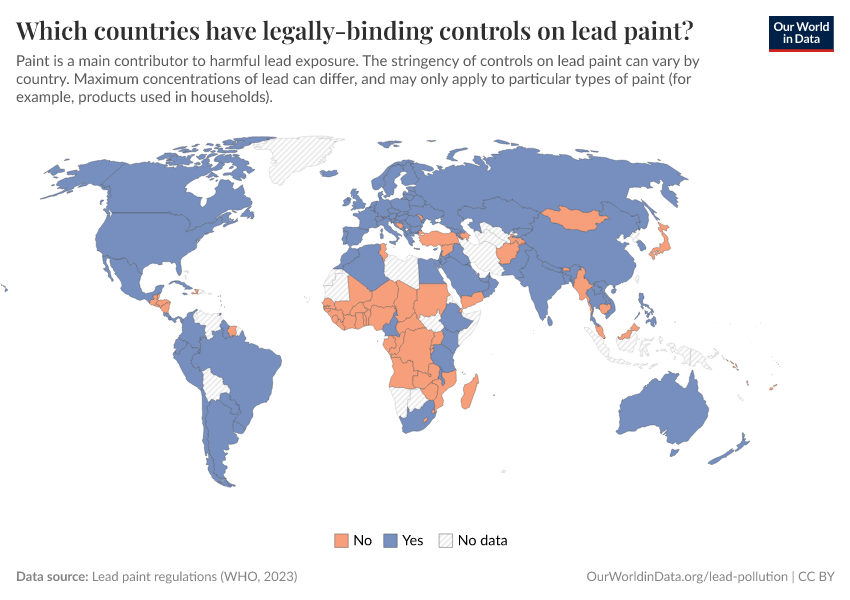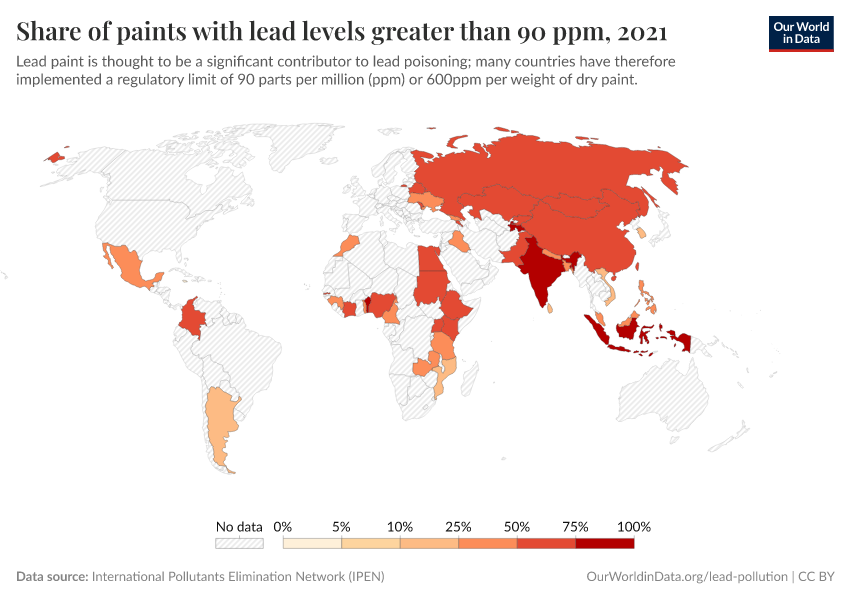Many countries have eliminated lead from paint. How do we achieve the same everywhere?
Paint is an important source of lead exposure. Which countries have regulations on its use?
Lead is an environmental toxin that is well-hidden, but has a large impact on global health. Particularly for children.
The main source of lead used to be leaded gasoline. But fortunately leaded gasoline in road vehicles is now banned in every country in the world.
Yet the WHO estimates that every third child in the world still suffers from lead poisoning.1 This lead could be coming from a range of sources, such as leaded pipes, batteries or electronic waste.2 Studies have even found very high levels of lead in cooking spices in some countries.3 One source that is of key concern is paint. Lead is often used in paint as a pigment to add color, to prevent corrosion and help it dry more quickly. Unfortunately this contaminates the surrounding environment, especially when used in households. It is particularly harmful for children, who are closer to the ground; and are more likely to put flakes of paint or dust in their mouths.
For this reason, many rich countries now have strict controls on the use of lead paints. Following the phase-out of leaded gasoline, the US CDC attributes its continued decline in lead poisoning to the regulation of paints in households.
In the map we see which countries have legally-binding controls on lead paints.
As we see in the chart, many countries still do not have any regulations. Children in low-to-middle income countries are most at risk, because they are still exposed to sources such as lead paint and pipes. To tackle this the UN set up the Global Alliance to Eliminate Lead Paint.4

Some countries still have very high concentrations of lead in paint
Many countries do not have regulations on the use of lead in paint, but is there evidence to suggest that this is a concern in the first place?
Yes, a range of studies have shown that lead concentrations in paints are very high across many countries. The International Pollutants Elimination Network (IPEN) have collated the results of more than 100 studies, across 59 countries, involving the testing of more than 4,000 solvent-based paints.
In the map here we see the share of tested paints that had lead levels greater than 600 parts per million (ppm) of the dry weight of paint. To put this into context, most countries with regulations state that lead levels must be below 90 parts per million. What we see is that in many low-to-middle income countries the majority of sold paints have lead concentrations well above the acceptable limits. It is the norm, rather than the exception. In fact, it is not uncommon to have paints with levels greater than 10,000 ppm.

Related charts
How do we eliminate the use of lead paint everywhere?
What are the barriers to eliminating lead paint everywhere?
Lead is not essential in paint – there are alternatives that work just as well. But is cost a barrier? Is it more expensive to make paints without lead? The evidence on this is mixed. There may be some initial up-front cost for paint manufacturers to change their formula. This is why government regulations are important: paint manufacturers would not have to fear that they’d lose out to cheaper competitors. There is also evidence that alternatives do not need to be costly. Some manufacturers in these countries already use lead-free paint, and it’s not more expensive than other paints on the market.5
Once reason might simply be a lack of awareness. In a country with many health challenges to prioritize, it’s easy to see why lead poisoning – which is a hidden problem – could be easily missed.
One project that is trying to raise awareness of this challenge with policymakers and paint formulators is the Lead Exposure Elimination Project (LEEP). In its first year it has already had success in driving policy change in Malawi; and making progress with several others.
You might assume that regulatory change is a slow process. But the case of leaded gasoline tells us a different story. In just four years every country in Sub-Saharan Africa banned it completely.
It could be an important win for global health if we could replicate this success for leaded paint.
Keep reading at Our World in Data
Endnotes
Here, lead poisoning is defined as having a blood lead concentration above 5 µg/dL – the WHO’s maximum acceptable threshold.
Ericson, B., Hu, H., Nash, E., Ferraro, G., Sinitsky, J., & Taylor, M. P. (2021). Blood lead levels in low-income and middle-income countries: a systematic review. The Lancet Planetary Health, 5(3), e145-e153.
Gleason, K., Shine, J. P., Shobnam, N., Rokoff, L. B., Suchanda, H. S., Ibne Hasan, M. O. S., ... & Mazumdar, M. (2014). Contaminated turmeric is a potential source of lead exposure for children in rural Bangladesh. Journal of Environmental and Public Health, 2014.
It set the target – which it has missed – of eliminating lead paint everywhere by 2020.
World Health Organization (2020). Global elimination of lead paint: why and how countries should take action. Technical brief. Geneva.
Cite this work
Our articles and data visualizations rely on work from many different people and organizations. When citing this article, please also cite the underlying data sources. This article can be cited as:
Hannah Ritchie (2022) - “Many countries have eliminated lead from paint. How do we achieve the same everywhere?” Published online at OurWorldinData.org. Retrieved from: 'https://archive.ourworldindata.org/20251222-145353/lead-paint.html' [Online Resource] (archived on December 22, 2025).BibTeX citation
@article{owid-lead-paint,
author = {Hannah Ritchie},
title = {Many countries have eliminated lead from paint. How do we achieve the same everywhere?},
journal = {Our World in Data},
year = {2022},
note = {https://archive.ourworldindata.org/20251222-145353/lead-paint.html}
}Reuse this work freely
All visualizations, data, and code produced by Our World in Data are completely open access under the Creative Commons BY license. You have the permission to use, distribute, and reproduce these in any medium, provided the source and authors are credited.
The data produced by third parties and made available by Our World in Data is subject to the license terms from the original third-party authors. We will always indicate the original source of the data in our documentation, so you should always check the license of any such third-party data before use and redistribution.
All of our charts can be embedded in any site.

